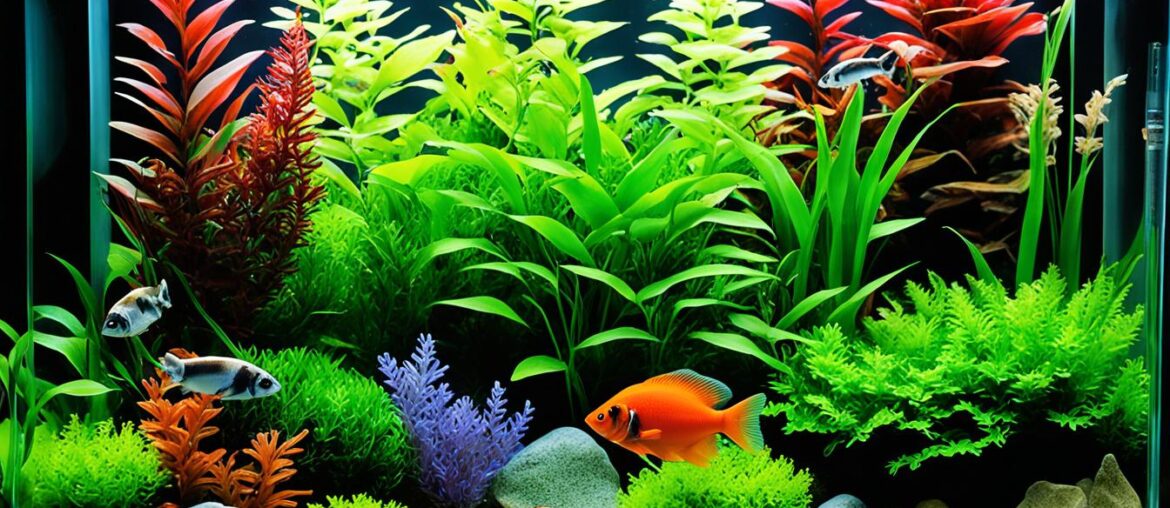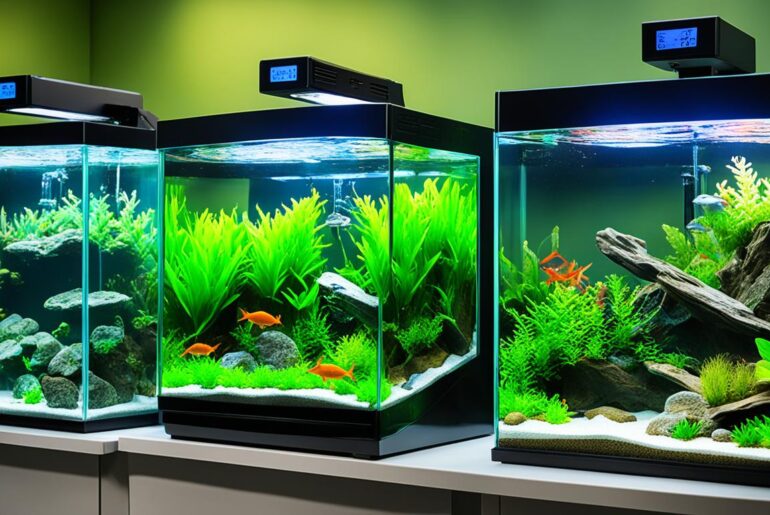As an avid aquarium enthusiast, I have always been captivated by the colorful beauty and graceful movements of fish gliding through the water. However, I have also experienced the heartbreak of losing beloved aquatic friends due to fluctuating temperatures in my freshwater tank. It was a painful lesson that taught me the crucial importance of maintaining a stable temperature in my aquarium for the health and well-being of my aquatic companions.
Whether you are new to the world of freshwater fishkeeping or have been a seasoned hobbyist for years, you can relate to the emotional connection we form with our fish. We care for them, nurture them, and create an environment that simulates their natural habitat. And one of the most critical factors in providing a healthy and thriving environment is temperature management.
In this article, I will share with you seven essential tips for maintaining a stable temperature in your freshwater tank. These tips, based on my personal experiences and insights from fellow fishkeepers, will help you create an optimal environment for your aquatic friends and ensure their well-being for years to come.
Key Takeaways:
- Fluctuating temperatures can cause stress and even death in fish, highlighting the importance of temperature stability in freshwater tanks.
- By following these seven tips, you can create a healthy and stable environment for your fish:
- 1. Properly manage water quality.
- 2. Treat the water before adding fish.
- 3. Understand the nitrogen cycle.
…
Test and monitor water quality
One of the key factors in maintaining a stable temperature in a freshwater tank is ensuring that the water quality is optimal. Testing the water regularly for ammonia and nitrite levels is essential to create a healthy and stable environment for your fish.
Ammonia and nitrite are two chemicals that can be harmful to fish, especially when they increase with changes in temperature. By monitoring and maintaining the proper water parameters, you can prevent these chemicals from reaching dangerous levels and ensure the well-being of your aquarium inhabitants. Regular testing and monitoring allow you to take necessary actions promptly to protect your fish.
Testing for water quality should include measuring parameters such as pH, ammonia, nitrite, nitrate, chlorine, and hardness. These parameters help understand the overall health of the aquarium and identify potential issues before they become serious problems.
Monitoring water parameters is a vital part of responsible fishkeeping. It allows you to make adjustments as needed, ensuring that your fish have a safe and comfortable habitat with stable water conditions.
By keeping a close eye on ammonia and nitrite levels, you can take appropriate measures to mitigate potential issues and maintain a stable temperature in your freshwater tank.
| Water Parameter | Ideal Range | Importance |
|---|---|---|
| pH | 6.5-7.5 | Optimal pH levels promote fish health and the growth of beneficial bacteria |
| Ammonia | 0 ppm | High ammonia levels are toxic and can harm fish |
| Nitrite | 0 ppm | High nitrite levels can cause fish stress and be lethal |
| Nitrate | 0-30 ppm | Excessive nitrate levels can negatively impact fish health |
| Chlorine | 0 ppm | Chlorine is toxic to fish and should be removed from the water |
| Hardness | 5-20 dKH | Appropriate hardness levels are vital for the overall health of fish |
Treat the water before adding fish
Before adding fish to your freshwater tank, it’s crucial to treat the water to remove chlorine and other harmful substances. This step is essential for creating a healthy and stable environment for your aquatic friends. One effective product that can help you achieve this is Tetra AquaSafe Solution.
Using Tetra AquaSafe Solution is a reliable method for treating water in a freshwater aquarium. It is specifically designed to neutralize chlorine, chloramine, and other harmful substances, making the water safe for your fish. With its advanced formula, this solution ensures that the water is free from any toxins that could be detrimental to the well-being of your aquatic pets.
When using Tetra AquaSafe Solution, it’s important to follow the proper dosage to achieve optimal results. For every gallon of water in your tank, you should add eight drops of AquaSafe Solution. This ensures that the water is properly treated and ready for the introduction of fish.
Treating the water before adding fish not only removes harmful substances but also helps to minimize stress in your fish. By creating a safe and stable environment, you can greatly increase the chances of your fish adapting to their new surroundings and thriving in their new home.
Here’s an image that illustrates the importance of treating water before adding fish:
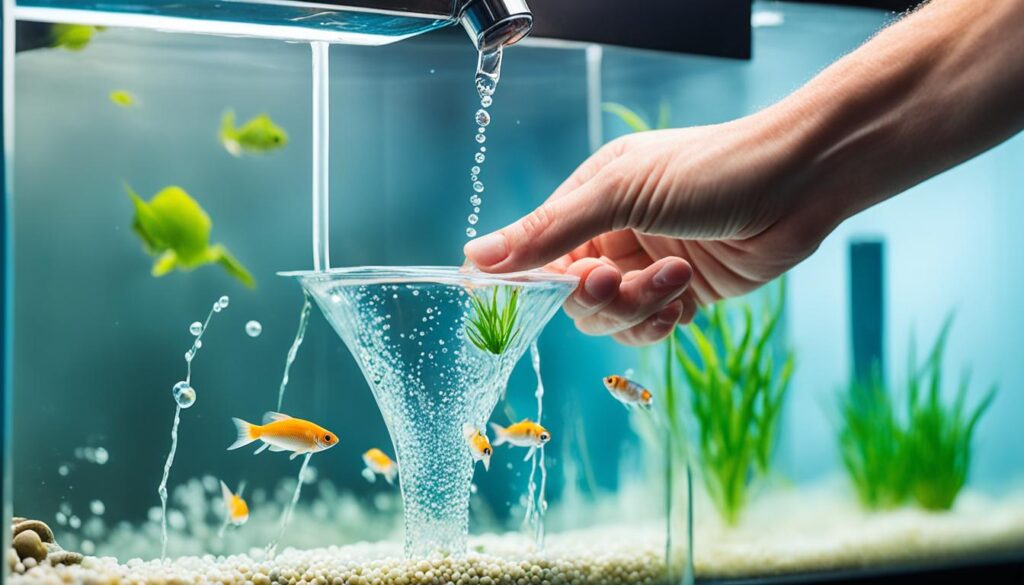
Remember, taking the time to treat your water properly is a crucial step in building a successful and healthy freshwater aquarium. By using Tetra AquaSafe Solution and following the recommended dosage, you can ensure that your fish will have the best environment possible, free from chlorine and harmful substances.
Understand the nitrogen cycle
The nitrogen cycle is a crucial process in maintaining a stable and healthy freshwater tank. It involves the growth of nitrifying bacteria that convert toxic ammonia into nitrite and then nitrate.
During the nitrogen cycle, fish waste and decaying organic matter produce ammonia, which is highly toxic to fish. Nitrosomonas bacteria then convert ammonia into nitrite, which is still harmful to fish. Finally, nitrobacter bacteria convert nitrite into nitrate, which is less toxic and can be removed through water changes or absorbed by live plants.
Understanding the nitrogen cycle is essential for maintaining a stable temperature in your freshwater tank. The presence of nitrifying bacteria helps to break down ammonia and nitrite, preventing them from reaching harmful levels and harming your fish.
One useful product for accelerating the establishment of the bio-filter in newly set-up aquariums is Tetra SafeStart Solution. It contains nitrifying bacteria that help kick-start the nitrogen cycle, reducing the time it takes for the tank to become fully cycled. This can be especially beneficial when adding fish to a new tank, as it helps to quickly establish a bio-filter that can manage the ammonia and nitrite levels.
By understanding and managing the nitrogen cycle in your aquarium, you can create a stable and healthy environment for your fish to thrive.
| Stage | Description | Duration |
|---|---|---|
| Nitrogen Cycle Start | Ammonia is produced by fish waste and decaying matter. | Immediate |
| Nitrosomonas bacteria | Ammonia is converted into nitrite. | 1-2 weeks |
| Nitrobacter bacteria | Nitrite is converted into nitrate. | 2-6 weeks |
| Mature Bio-filter | Nitrate is removed through water changes or absorbed by plants. | Ongoing |
Seek advice on tap water quality
When it comes to maintaining a stable temperature in your freshwater tank, the quality of tap water plays a crucial role. The tap water you use to fill your tank can contain various substances that may affect the well-being of your fish. Two important factors to consider are the pH and hardness levels of the water. These parameters can vary depending on your location and can have a significant impact on the health of your fish.
Chlorine and chloramine are commonly found in tap water, and these chemicals are used to treat and disinfect water in many municipal water systems. However, they can be harmful to fish if not neutralized. Chlorine, in particular, can damage the delicate gills and skin of fish, leading to stress and illness.
I always recommend seeking advice from experts or experienced aquarists to ensure that the tap water you use is suitable for your aquarium. They can provide valuable insights and recommendations based on your specific water parameters and the type of fish you plan to keep.
To neutralize chlorine and chloramines in tap water, you can use Tetra AquaSafe Solution. This reliable product is specifically designed to make tap water safe for aquarium use. It effectively removes chlorine, chloramine, and other harmful substances, allowing you to provide a safer environment for your fish.
By using Tetra AquaSafe Solution according to the recommended dosage, which is eight drops per gallon of water, you can confidently add tap water to your tank without worrying about the negative effects of chlorine and chloramines. This will contribute to maintaining a stable temperature in your freshwater tank and promoting the overall health of your fish.
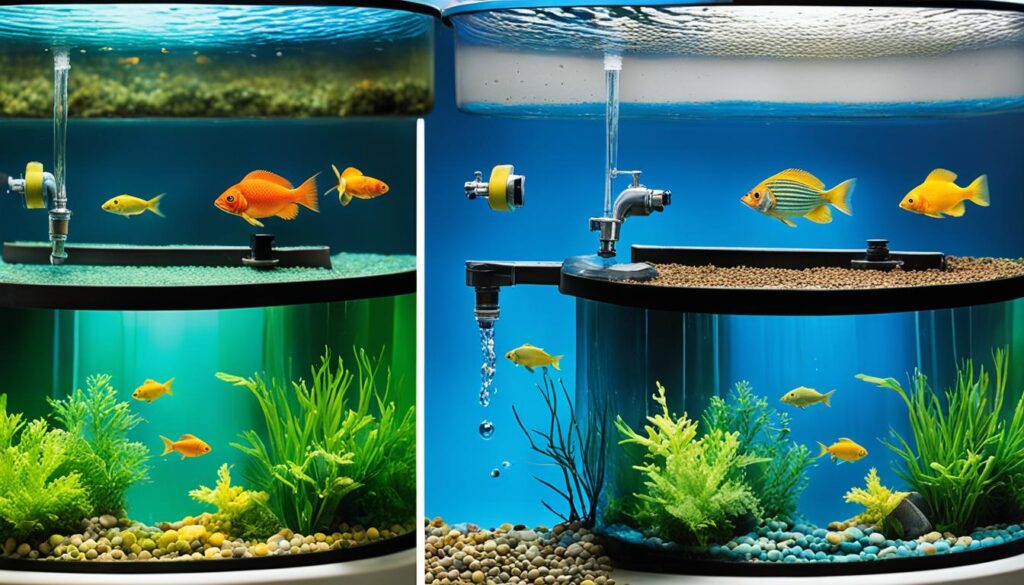
Remember, the tap water quality can significantly impact the stability of temperature in your freshwater tank. It’s essential to consider the pH and hardness levels, as well as the presence of chlorine and chloramines in tap water. Consulting experts and using products like Tetra AquaSafe Solution are valuable steps in creating a safer and healthier environment for your fish.
Monitor and adjust water parameters
Monitoring and adjusting water parameters is essential for maintaining a stable temperature in your freshwater tank. By regularly testing and adjusting parameters such as nitrate, nitrite, total hardness, total chlorine, total alkalinity, and pH levels, you can ensure a healthy and balanced environment for your fish.
When it comes to monitoring water parameters, there are several key factors to consider. Nitrate and nitrite levels, for example, can indicate the overall water quality in your tank. High levels of nitrate and nitrite can be harmful to fish, so it’s important to test and adjust these parameters as needed.
Additionally, total hardness and total chlorine levels should also be monitored. Total hardness measures the mineral content in your water, while total chlorine levels indicate the presence of chlorine, which can be harmful to fish. By monitoring and adjusting these parameters, you can create a more suitable living environment for your aquatic friends.
The total alkalinity of your water is another important parameter to consider. It measures the water’s ability to resist changes in pH levels. Maintaining a stable alkalinity is crucial for preventing drastic fluctuations in pH, which can be stressful for fish. Regular testing and adjustments can help ensure stable alkalinity levels in your tank.
Finally, pH levels play a vital role in the overall health and well-being of your fish. Different species of fish have specific pH requirements, so it’s important to monitor and adjust pH levels accordingly. Using products like Tetra EasyBalance Solution and Correct pH can help maintain the optimal water parameters for your specific fish species.
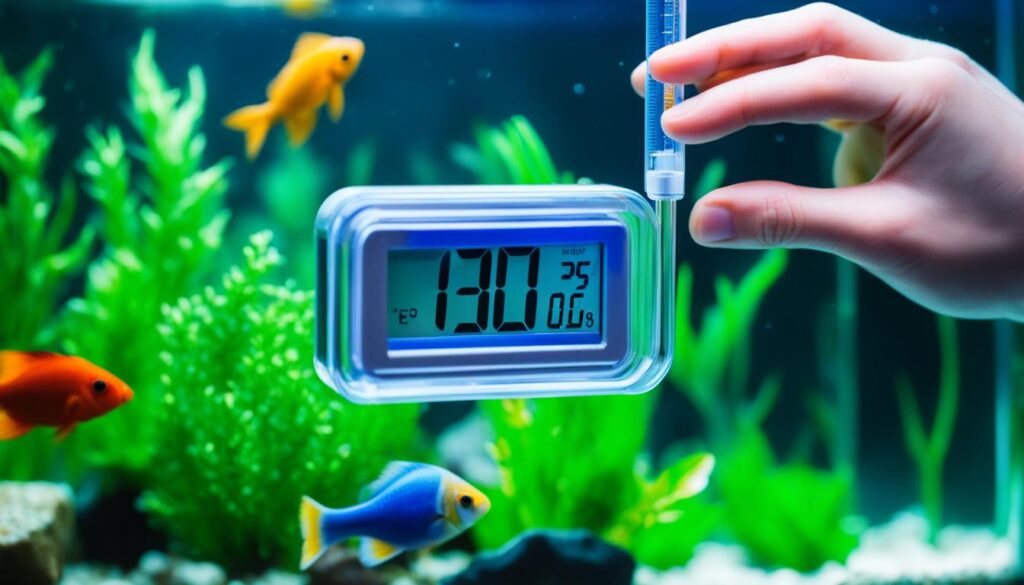
“Properly monitoring and adjusting water parameters is crucial for the overall health and well-being of your fish. By maintaining optimal levels of nitrate, nitrite, total hardness, total chlorine, total alkalinity, and pH, you can create a stable and comfortable environment for your aquatic friends.” – Your Name
Control sunlight and heat sources
When it comes to maintaining a stable temperature in your freshwater tank, it’s important to be mindful of sunlight and heat sources. These factors can have a significant impact on the temperature in your tank and can disrupt the delicate balance required for the health of your fish.
Preventing sunlight in the fish tank:
Direct sunlight can quickly raise the temperature of your tank, leading to stress and discomfort for your fish. To prevent sunlight from reaching the tank, place it away from windows or use curtains to block out the light. This will help maintain a more stable temperature and create a comfortable environment for your aquatic friends.
Avoiding heat sources near the aquarium:
Heat sources such as radiators and air conditioners can also impact the temperature of your tank. Placing your aquarium away from these sources will prevent unnecessary fluctuations in temperature. Additionally, it’s essential to avoid placing any heating devices near the tank, as this can cause uneven heating and temperature spikes.
Maintaining a stable ambient temperature:
In addition to preventing direct sunlight and avoiding heat sources, it’s crucial to maintain a stable ambient temperature in the room where your tank is located. Sudden changes in room temperature can affect the temperature of the tank, so try to keep the room at a consistent temperature. Using a thermometer will help you monitor and adjust the room temperature accordingly.
“By controlling sunlight and heat sources, you can prevent unwanted temperature fluctuations in your freshwater tank and provide a stable environment for your fish to thrive.”
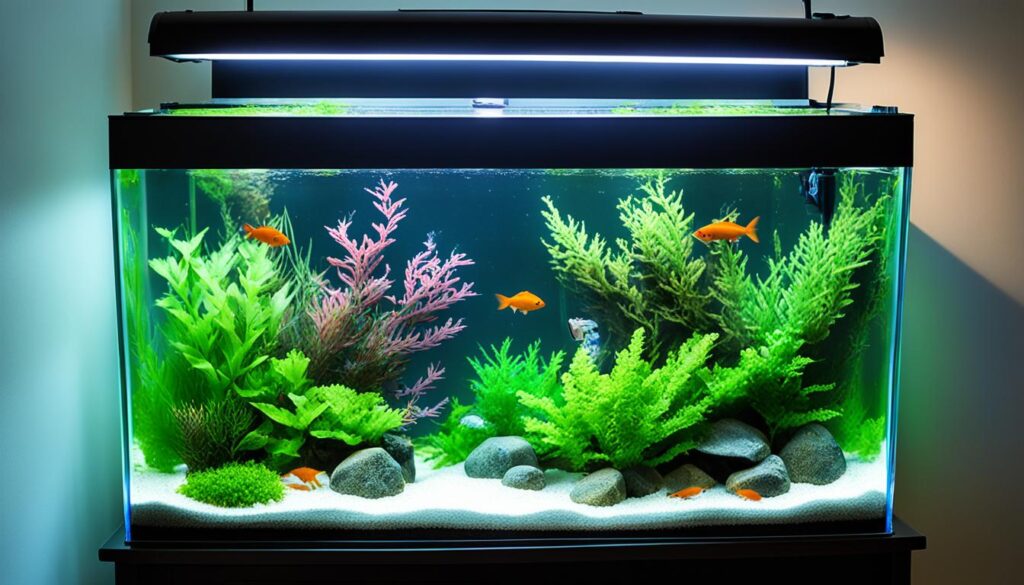
Tips to control sunlight and heat sources:
- Place the tank away from windows or use curtains to block sunlight.
- Avoid placing the tank near radiators and air conditioners.
- Maintain a stable ambient temperature in the room where the tank is located.
- Use a room thermometer to monitor and adjust the temperature as needed.
Use appropriate aquarium heaters
Choosing the right aquarium heater is crucial for maintaining a stable temperature in your freshwater tank. Submersible heaters are the most popular choice and come in adjustable and pre-set options. It’s important to select a heater with the proper wattage rating for your tank size. Safety precautions should also be taken, such as never removing a heater from the water while it is still turned on.
Submersible Heaters
Submersible heaters are designed to be fully submerged in the water of your aquarium. This allows for efficient heat distribution and accurate temperature control. They come in various sizes and wattages to suit different tank sizes and temperature needs.
“Submersible heaters are my go-to choice for maintaining a stable temperature in my freshwater tank. They are easy to install, provide even heat distribution, and allow for precise temperature adjustments.”
Adjustable Heaters
Adjustable heaters offer the convenience of adjusting the temperature according to the specific needs of your fish and plants. These heaters typically have a dial or digital display that allows you to set and monitor the desired temperature range.
“I prefer using adjustable heaters as they give me full control over the temperature in my aquarium. I can easily adjust the heat settings depending on the preferences of my fish species.”
Wattage Rating
When selecting an aquarium heater, it’s important to consider the wattage rating. The wattage rating determines the heating capacity of the heater and should be suitable for the size of your tank. As a general rule, it is recommended to use around 5 watts per gallon of water for standard aquariums.
“I always make sure to choose a heater with the appropriate wattage rating for my tank size. This ensures that the temperature is adequately regulated and prevents overheating or underheating.”
Safety Precautions
Ensuring the safety of your aquarium and its inhabitants is essential when using an aquarium heater. Here are some safety precautions to keep in mind:
- Never remove a heater from the tank while it is still turned on.
- Always unplug the heater before making any adjustments or performing maintenance.
- Regularly inspect the heater for any signs of damage or malfunction.
- Use a heater guard or cover to prevent direct contact between fish and the heater.
By following these safety precautions, you can minimize the risk of accidents and ensure the well-being of your fish and plants.

| Type of Heater | Pros | Cons |
|---|---|---|
| Submersible Heater |
|
|
| Adjustable Heater |
|
|
Implement cooling methods in hot weather
During hot weather, it’s important to implement cooling methods to maintain a stable temperature in your freshwater tank. Here are some effective methods:
- Floating ice bottles: Place frozen water bottles in the tank. As the ice melts, it will cool the water.
- Turn down the heater: Reduce the temperature setting on your aquarium heater, but be careful not to turn it off completely.
- Maintain oxygen levels: Ensure good water circulation to maintain oxygen levels. Use an air stone or adjust the flow of your filter.
- Close curtains: Block out direct sunlight by closing the curtains or blinds near the tank. This will help reduce heat absorption.
- Open the aquarium cover: Increase air circulation by partially or fully opening the aquarium cover.
- Avoid overstocking: Overstocking can increase the temperature in the tank. Keep a balance between the number of fish and the tank capacity.
- Frequent water changes: Perform regular water changes with slightly cooler water to help maintain a stable temperature.
- Adjust feeding: Reduce the amount of food you give to your fish. Digestion generates heat, so feeding less can help lower the temperature.
- Minimize lighting: Turn off or reduce the duration of artificial lighting in the tank. Light can contribute to increased temperature.
By implementing these cooling methods, you can help ensure that your fish stay comfortable and healthy even during hot weather.
Remember to monitor the temperature regularly and make adjustments as needed. If you’re unsure about the specific requirements of your fish species, consult with a knowledgeable aquarium specialist.
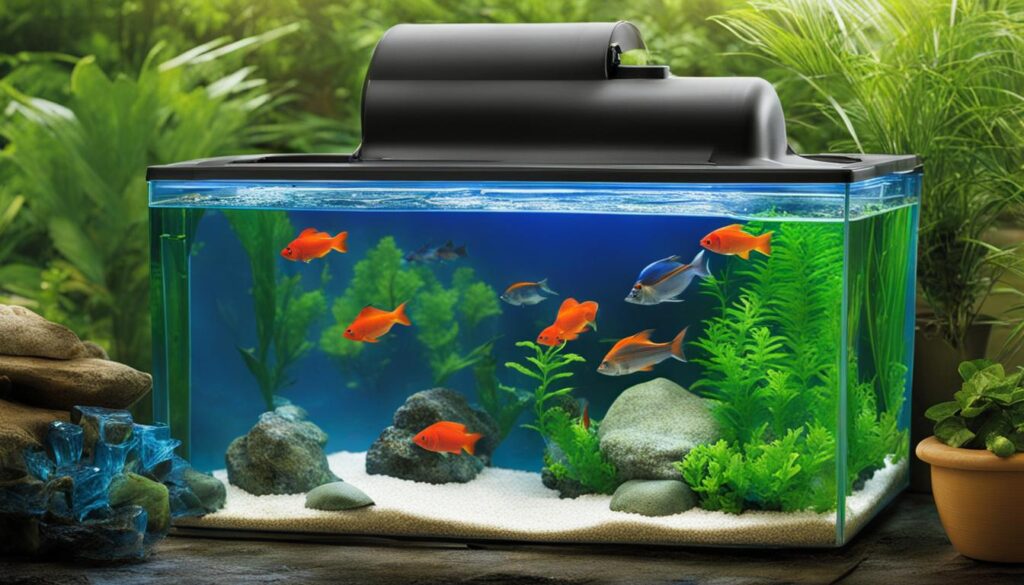
Note: The image above illustrates the concept of using floating ice bottles to cool the water in your fish tank.
Conclusion
Maintaining a stable temperature in your freshwater tank is crucial for the health and well-being of your fish. By properly managing water quality, treating the water before adding fish, understanding the nitrogen cycle, monitoring water parameters, and implementing cooling methods, you can create a stable and healthy environment for your aquatic friends.
Regularly testing and adjusting water parameters is vital to ensure the ideal conditions for your fish. Seek advice from experts if needed, as they can provide valuable insights and guidance throughout your freshwater tank journey. With proper temperature management, you can enjoy a thriving and enjoyable freshwater tank that brings you and your fish endless delight.
Remember, the well-being of your fish depends on your care and attention. By following the tips outlined in this guide and staying proactive in your maintenance routine, you can maintain a stable temperature in your freshwater tank and provide your fish with the optimal conditions they need to thrive. Keep learning, experimenting, and adapting as you continue your freshwater tank journey, and watch as your aquatic friends flourish in their stable and comfortable home.
FAQ
How can I maintain a stable temperature in my freshwater tank?
To maintain a stable temperature in your freshwater tank, follow these tips: manage water quality, treat the water before adding fish, understand the nitrogen cycle, test water regularly, control sunlight and heat sources, use appropriate aquarium heaters, and implement cooling methods in hot weather.
Why is water quality important for maintaining temperature stability?
Water quality is important for maintaining temperature stability because changes in temperature can affect the levels of ammonia and nitrite, which can be harmful to fish. By monitoring and maintaining water quality, you can create a stable environment for your fish.
How should I treat the water before adding fish?
Before adding fish to your freshwater tank, it’s important to treat the water to remove chlorine and other harmful substances. One effective product for this is Tetra AquaSafe Solution. The proper dosage of AquaSafe Solution is eight drops per gallon of water. By treating the water before adding fish, you can create a healthy and stable environment for your aquatic friends.
What is the nitrogen cycle and why is it important?
The nitrogen cycle is a crucial process in maintaining a stable and healthy freshwater tank. It involves the growth of nitrifying bacteria that convert toxic ammonia into nitrite and then nitrate. Understanding the nitrogen cycle and the importance of cycling a tank is essential for maintaining stable temperature in your freshwater tank. One useful product for accelerating the establishment of the bio-filter in newly set-up aquariums is Tetra SafeStart Solution.
How does tap water quality affect my freshwater tank?
Tap water quality can greatly affect the temperature stability in your freshwater tank. pH and hardness levels should be considered when selecting fish for your tank. It’s also important to know if your tap water contains chlorine or chloramine, as these chemicals can be harmful to fish. Using Tetra AquaSafe Solution can help neutralize chlorine and chloramines in tap water, creating a safer environment for your fish.
How can I monitor and adjust water parameters?
Monitoring and adjusting water parameters is essential for maintaining a stable temperature in your freshwater tank. Parameters like nitrate, nitrite, total hardness, total chlorine, total alkalinity, and pH levels should be regularly tested and adjusted if necessary. Products like Tetra EasyBalance Solution and Correct pH can help maintain the optimal water parameters for your fish.
How can I control sunlight and heat sources?
Sunlight and heat sources can greatly impact the temperature in your freshwater tank. It’s important to prevent direct sunlight from reaching the tank and to keep the aquarium away from heat sources like radiators and air conditioners. Maintaining a stable ambient temperature in the room where the tank is located can also help in maintaining a stable temperature in the tank.
What type of aquarium heater should I use?
Choosing the right aquarium heater is crucial for maintaining a stable temperature in your freshwater tank. Submersible heaters are the most popular choice and come in adjustable and pre-set options. It’s important to select a heater with the proper wattage rating for your tank size. Safety precautions should also be taken, such as never removing a heater from the water while it is still turned on.
How can I implement cooling methods in hot weather?
During hot weather, it’s important to implement cooling methods to maintain a stable temperature in your freshwater tank. Some effective methods include floating ice bottles to cool the water, turning down the heater (but not turning it off completely), maintaining oxygen levels through good water circulation, closing curtains to reduce sunlight, opening the aquarium cover to increase air circulation, avoiding overstocking, performing frequent water changes with slightly cooler water, adjusting feeding, and minimizing lighting.
Why is maintaining a stable temperature important for my fish?
Maintaining a stable temperature in your freshwater tank is essential for the health and well-being of your fish. Fluctuating temperatures can cause stress and even death in fish. By following the tips provided, you can create a stable and healthy environment for your aquatic friends.
